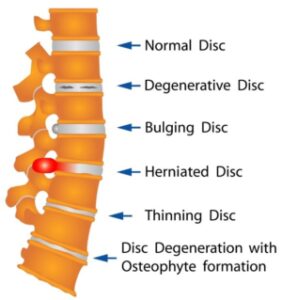 What is a spinal disc?
What is a spinal disc?
A spinal disc or intervertebral disc rests between adjacent vertebra in the spine and acts as a shock absorber and as a pivot point for movement of the spine into rotation, lateral flexion, flexion and extension. The discs also help protect the nerves that run down the spine and between the vertebrae.
It is a cushion of fibrocartilage and there are 23 of them in the human spine: 6 in the cervical region (neck), 12 in the thoracic region (middle back), and 5 in the lumbar region (lower back).
The thickness of the discs is relative to the size of the vertebral bodies and is highest in the cervical and lumbar regions which reflects the increased range of motion found in those regions.
In the cervical and lumbar regions, the intervertebral discs are thicker anteriorly which creates the secondary curvature of the spine – aka as the cervical lordosis and lumber lordosis respectively.
Your body needs plenty of water to function at its best and the spine is no exception! Unfortunately, the spine is not able to absorb water as easily as other parts of the body and is instead dependent on the motion of the spinal discs which act as a pump to move the fluid around. This process is known as imbibition. Imbibition is necessary for the spine to receive essential nutrients.
A normal vertebral disc is approximately 90% water. Maintaining this healthy percentage is dependent on drinking plenty of water throughout each day and getting enough movement of the spine to activate the transport of fluids within the discs. The typical “rule” suggests drinking 2 litres of water each day, but this of course increases for those with higher levels of physical activity, particularly when working outdoors in high temperatures. When it comes to movement, leading a sedentary lifestyle can contribute to a loss of water in the vertebral discs and eventually cause disc degeneration and chronic pain. This tends to be particularly common among the elderly as they are no longer able to lead as active of a lifestyle as they once were.
The picture above reveals the different types of disc injuries that commonly present to The Thames Clinic. Our experienced Chiropractors can generally palpate areas of disc injuries within the spine and would normally recommend an x-ray to show the extent any disc injury. Importantly there are plenty of options for treatment for these disc problems but it is important to identify them and manage them accordingly with the right exercises and the correct treatment.
Another important factor that affects spinal hydration is sleep. Each night while you sleep, your body restores some of the water that was lost during the day to the spinal discs, but not all of it. Some have suggested that because of this, it is best to give yourself sometime after waking up (about an hour) in the morning before doing any heavy bending so that some of that water in the discs has the chance to disperse. In addition to a good night’s sleep, chiropractic care can of course help improve how your spine functions and feels!
With good hydration, an active lifestyle and regular visits to the chiropractor, you will be taking major strides towards getting your spine healthy!


